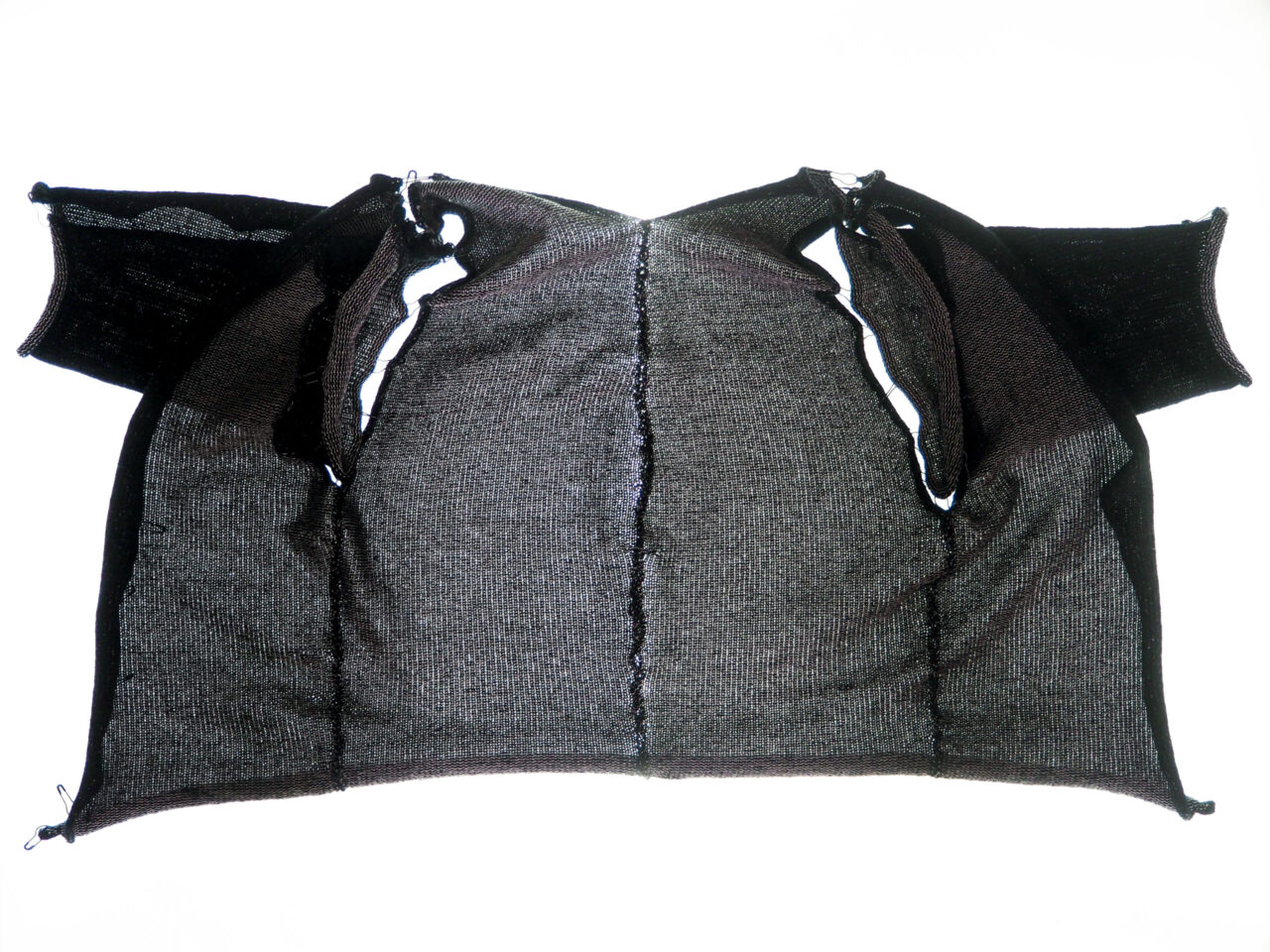Eilidh Nuala Duffy talks to the designer about the endless possibilities of wear

Testing water-soluble yarn. As the wearer sweats, the yarn shrinks, liquifies and then hardens
Izzy Fulford graduated from the BA Design degree at Goldsmiths in 2020. After finding herself working from home during the last stint of her education, Izzy realised that she was granted more freedom to develop techniques she’d been told by tutors would be too time-consuming to explore.
For her dissertation, Izzy had researched the embodied experience of wearing clothes within the context of horse-riding. She used her riding boots as a starting point, demonstrating how wearing the boots – ‘wearing them in’ – was an essential process in making them useful. She then decided to use her final project to explore ways in which she could use the functioning of one’s body to create productive wear in clothing. The result was three different garments, each using a different technique to change the piece through direct contact with the body.
Although all clothing we wear changes with us, Izzy’s work exaggerates the relationship between body and garment, developing new ways of perceiving this interaction. It can be a functional process in itself, symbiotic with the body, rather than purely destructive.


The viscose and water soluble knit top before and after use
Eilidh: Can you give us a bit of an overview of the project?
Izzy: So there were three processes I ended up working with. For the first I used a water soluble filament using a technique on the knitting machine called plaiting, which is where you can create a double sided fabric with one yarn on one side and one yarn on the other. So this was black viscose backed with a water-soluble yarn. Then I tried to use the body’s heat and moisture to felt wool gloves while cycling. And the final thing I did was work with silk steel, so when you stretch the garment it remembers its shape. With this you can create a memory of the body’s movement in clothing.
E: Why did you use knitwear as a starting point?
I: I became interested in knitting because I really liked the idea of being able to create my own fabrics. I also really liked how there’s so much folklore that surrounds knitwear. After I started knitting, I then became interested in how I could create a fabric which reacts to the body – something that actually changes through wear. I was also thinking about wear being seen as a destructive, negative thing but actually it can actually be a very positive thing.
Like with horse riding boots: when you first get them they’re very tight and painful to wear. You have to break them in but then they become exclusively yours – they physically show the marks of where you’ve worn them and how you’ve worn them in.
I guess the main outcome from the project was the fabric I created which is water soluble on one side. As you sweat the yarn liquifies and then hardens in the areas in which you sweat, so it changes structure. But, honestly, what’s missing from this is how it becomes a totally productive thing.
E: So the interaction between the body and the garment transforms the garment. But then the garment itself becomes hard and uncomfortable. The process is very beautiful and evocative but, to an extent, pretty useless.
I: Yeah, exactly. It leads to a lot of open ended questions for sure.
E: The felting – did that actually work?
I: Obviously it wasn’t an extremely dramatic result but it worked a little. All you need for felting is moisture, heat and friction and the body can produce all of those things on its own. I made these gloves that I cycled in and the fibres did mesh together with the moisture from my hands and the friction from the handlebars.

Woollen gloves which were partially felted from the moisture, heat and friction created by cycling
E: I love the streamlined element to all of this, as if the process is a byproduct of living.
I: Yeah exactly! Just using the processes that exist in the body already to manipulate fibres.
E: So why clothes?
I: The summer of my second year at Goldsmiths I interned at a women’s motorcycle clothing brand. I’ve always been into functional technical clothing and being there I realised that this is something that I really love. I’m really interested in how clothes can be an extension to the body in a way that allows you to actually do something.
E: So what is it about functional vs. aesthetic design that interests you?
I: To say that aesthetics don’t interest me is definitely not true. I don’t think anyone that does design is not into how something looks but maybe it’s the functional side of aesthetics I’m interested in.
E: What are you working on now?
I: I’ve started experimenting with acid using a technique called devoré. Traditionally it’s done with velvet, so you have a cellulose fibre and a protein fibre and if you use this special type of acid, you can get the acid to eat away at the cellulose and just leave the protein backing. So I’ve been doing this with a knit: I’ve been knitting with these two different fibres and then trying to get it to eat away little bits.
*****